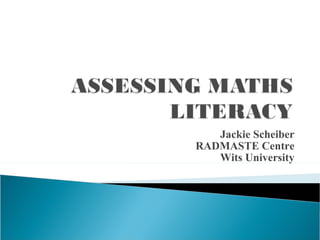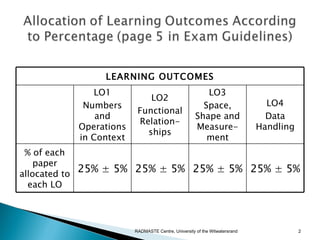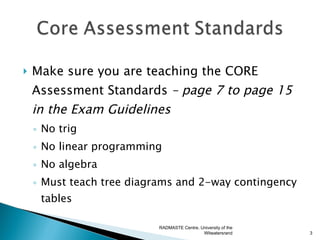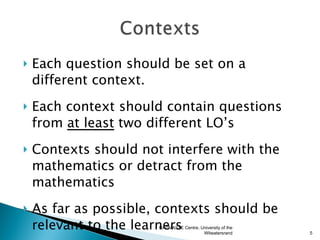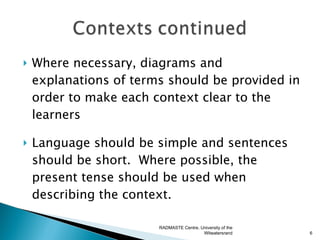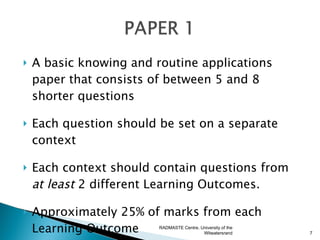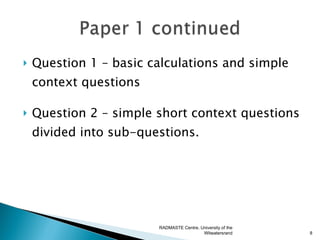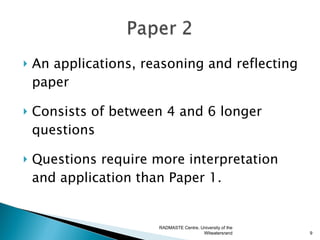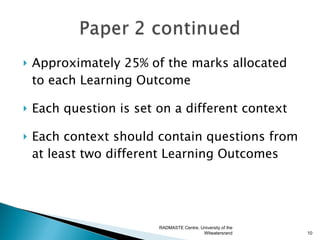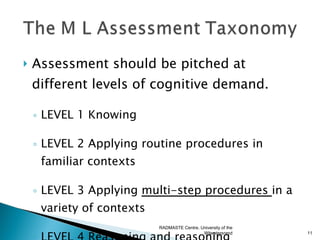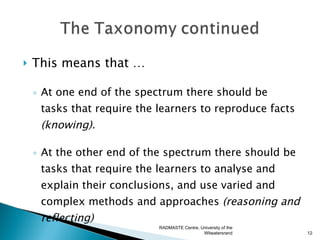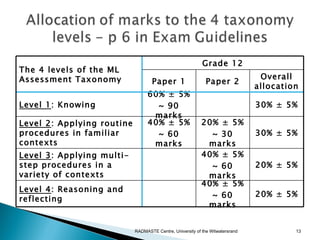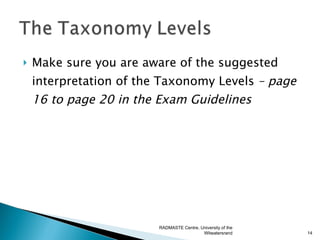Assessing Maths Lit Exams
- 1. Jackie Scheiber RADMASTE Centre Wits University
- 2. LEARNING OUTCOMES LO1 LO3 LO2 Numbers Space, LO4 Functional and Shape and Data Relation- Operations Measure- Handling ships in Context ment % of each paper allocated to 25% ┬▒ 5% 25% ┬▒ 5% 25% ┬▒ 5% 25% ┬▒ 5% each LO RADMASTE Centre, University of the Witwatersrand 2
- 3. ’üĮ Make sure you are teaching the CORE Assessment Standards ŌĆō page 7 to page 15 in the Exam Guidelines ŌŚ” No trig ŌŚ” No linear programming ŌŚ” No algebra ŌŚ” Must teach tree diagrams and 2-way contingency tables RADMASTE Centre, University of the Witwatersrand 3
- 4. ’üĮ TABLES ŌŚ” Tables that show Functional Relationships - LO2. ŌŚ” All other tables - LO4. ’üĮ CONVERSIONS ŌŚ” Money conversions fall under LO1 ŌŚ” Conversions of measurements fall under LO3 RADMASTE Centre, University of the Witwatersrand 4
- 5. ’üĮ Each question should be set on a different context. ’üĮ Each context should contain questions from at least two different LOŌĆÖs ’üĮ Contexts should not interfere with the mathematics or detract from the mathematics ’üĮ As far as possible, contexts should be relevant to the learners RADMASTE Centre, University of the Witwatersrand 5
- 6. ’üĮ Where necessary, diagrams and explanations of terms should be provided in order to make each context clear to the learners ’üĮ Language should be simple and sentences should be short. Where possible, the present tense should be used when describing the context. RADMASTE Centre, University of the Witwatersrand 6
- 7. ’üĮ A basic knowing and routine applications paper that consists of between 5 and 8 shorter questions ’üĮ Each question should be set on a separate context ’üĮ Each context should contain questions from at least 2 different Learning Outcomes. ’üĮ Approximately 25% of marks from each Learning Outcome RADMASTE Centre, University of the Witwatersrand 7
- 8. ’üĮ Question 1 ŌĆō basic calculations and simple context questions ’üĮ Question 2 ŌĆō simple short context questions divided into sub-questions. RADMASTE Centre, University of the Witwatersrand 8
- 9. ’üĮ An applications, reasoning and reflecting paper ’üĮ Consists of between 4 and 6 longer questions ’üĮ Questions require more interpretation and application than Paper 1. RADMASTE Centre, University of the Witwatersrand 9
- 10. ’üĮ Approximately 25% of the marks allocated to each Learning Outcome ’üĮ Each question is set on a different context ’üĮ Each context should contain questions from at least two different Learning Outcomes RADMASTE Centre, University of the Witwatersrand 10
- 11. ’üĮ Assessment should be pitched at different levels of cognitive demand. ŌŚ” LEVEL 1 Knowing ŌŚ” LEVEL 2 Applying routine procedures in familiar contexts ŌŚ” LEVEL 3 Applying multi-step procedures in a variety of contexts RADMASTE Centre, University of the Witwatersrand 11
- 12. ’üĮ This means that ŌĆ” ŌŚ” At one end of the spectrum there should be tasks that require the learners to reproduce facts (knowing). ŌŚ” At the other end of the spectrum there should be tasks that require the learners to analyse and explain their conclusions, and use varied and complex methods and approaches (reasoning and reflecting) RADMASTE Centre, University of the Witwatersrand 12
- 13. Grade 12 The 4 levels of the ML Assessment Taxonomy Overall Paper 1 Paper 2 allocation 60% ┬▒ 5% Level 1: Knowing ~ 90 30% ┬▒ 5% marks Level 2: Applying routine 40% ┬▒ 5% 20% ┬▒ 5% procedures in familiar ~ 60 ~ 30 30% ┬▒ 5% contexts marks marks Level 3: Applying multi- 40% ┬▒ 5% step procedures in a ~ 60 20% ┬▒ 5% variety of contexts marks 40% ┬▒ 5% Level 4: Reasoning and ~ 60 20% ┬▒ 5% reflecting marks RADMASTE Centre, University of the Witwatersrand 13
- 14. ’üĮ Make sure you are aware of the suggested interpretation of the Taxonomy Levels ŌĆō page 16 to page 20 in the Exam Guidelines RADMASTE Centre, University of the Witwatersrand 14
- 15. 1. Get into small groups 2. Look at the resources/context sheets and decide which context your group is going to work on 3. Taking all the technical requirements into account, design ONE question of between 10 and 20 marks using your context 4. Write your question on the flip chart paper 5. Indicate the LOŌĆÖs covered and the taxonomy RADMASTE Centre, University of the levels of each sub-question. Witwatersrand 15

